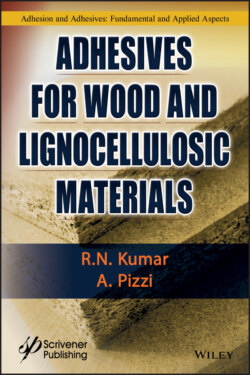Читать книгу Adhesives for Wood and Lignocellulosic Materials - R. N. Kumar - Страница 70
2.17 Covalent Bond Formation
ОглавлениеCovalent bonds between an adhesive and wood are believed to improve bond durability. Although covalent bonds—chemical bonds between the adhesive and wood—seem plausible with some adhesives, they have never been unambiguously detected in an adhesive bondline and no evidence exists that they contribute to the strength of adhesive bonds To determine whether an adhesive forms covalent bonds to wood, it must have the following characteristics: (1) be highly reactive with wood polymer hydroxyls, (2) be capable of permeating the cell wall, (3) exhibit strong wettability to wood, and (4) be amenable to study using a monofunctional model compound. Ideally, the reaction between the monofunctional model compound and wood will produce distinct chemical shift differences between unreacted and reacted wood polymers in solution-state nuclear magnetic resonance (NMR) spectroscopy.
While there is no doubt that adhesive-to-wood covalent bonds can form under specific experimental conditions, the conditions employed in studies reporting such bond formation generally have not corresponded to the conditions commonly used in the bonding of wood, in particular hot-pressing of wood panels [52]. For instance, covalent bonds between wood and a synthetic adhesive can form at temperatures higher than 120°C maintained for 2 h [52]. But extensive covalent bonding appears unlikely in the core of a particleboard, which is able to reach only 115° to 120°C for no more than 1 to 1.5 min when pressed at 200°C for 3 min. Allan and Neogi found in the case of phenol-formaldehyde bonding of wood at 120°C for 2 h that only one adhesive-to-substrate covalent bond was formed for approximately every 1200 cross-links within the resin itself [53]. This was also the case for isocyanate binders, for which the original misconception of a predominance of covalent bonding between adhesive and substrate that has been used to explain the high strength of the panels obtained in that manner was disproved [54, 55].
